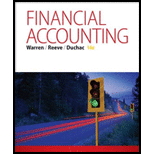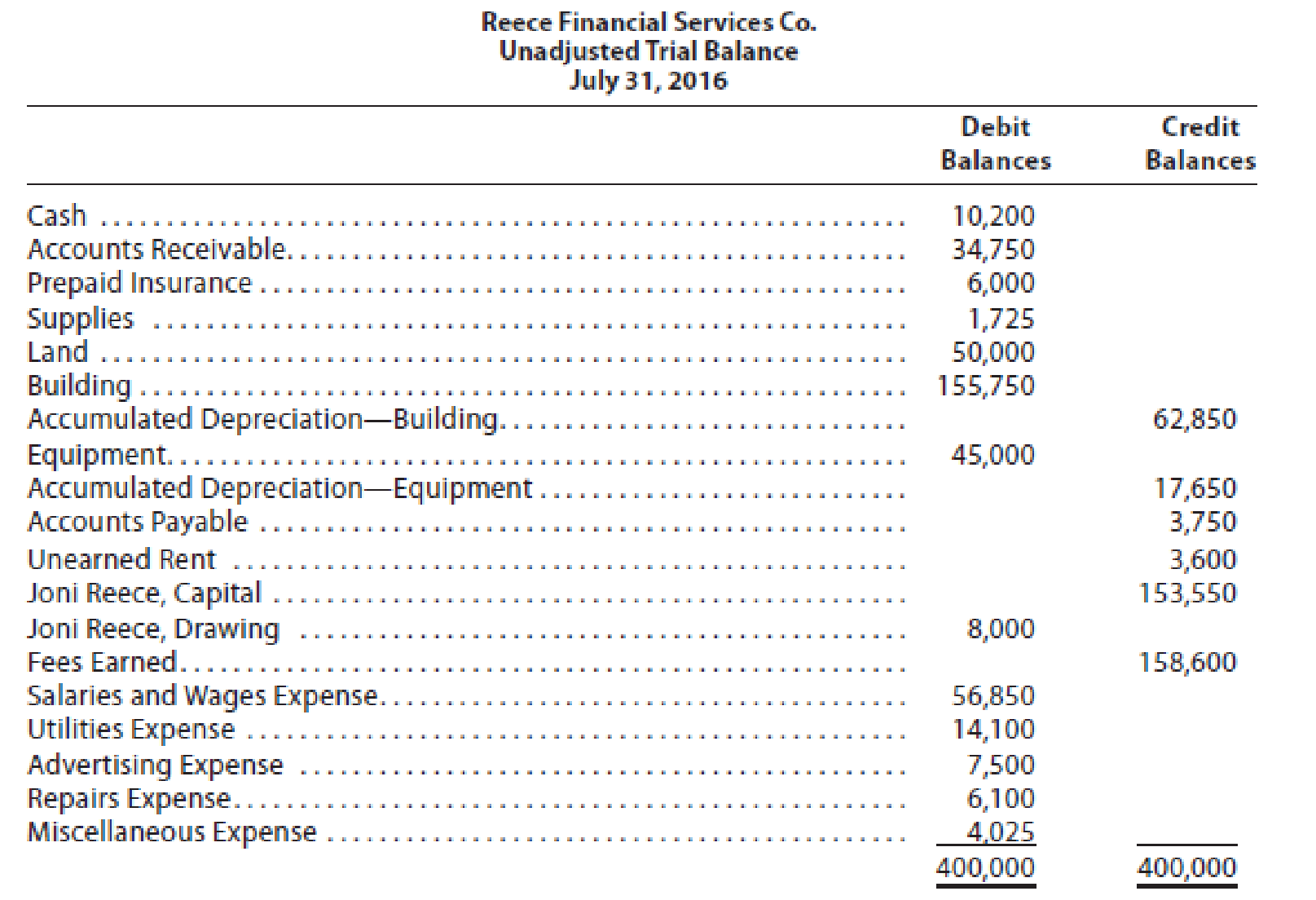
Concept explainers
Reece Financial Services Co., which specializes in appliance repair services, is owned and operated by Joni Reece. Reece Financial Services Co.’s accounting clerk prepared the following unadjusted

The data needed to determine year-end adjustments are as follows:
- a.
Depreciation of building for the year, $6,400. - b. Depreciation of equipment for the year, $2,800.
- c. Accrued salaries and wages at July 31, $900.
- d. Unexpired insurance at July 31, $1,500.
- e. Fees earned but unbilled on July 31, $10,200.
- f. Supplies on hand at July 31, $615.
- g. Rent unearned at July 31, $300.
Instructions
- 1. Journalize the
adjusting entries using the following additional accounts: Salaries and Wages Payable; Rent Revenue; Insurance Expense; Depreciation Expense—Building; Depreciation Expense—Equipment; and Supplies Expense. - 2. Determine the balances of the accounts affected by the adjusting entries and preparean adjusted trial balance.
(1)
Record the adjusting entries on July 31, 2016 of Company RFS.
Explanation of Solution
Adjusting Entries
Adjusting entries indicates those entries, which are passed in the books of accounts at the end of one accounting period. These entries are passed in the books of accounts as per the revenue recognition principle and the expenses recognition principle to adjust the revenue, and the expenses of a business in the period of their occurrence.
Rule of Debit and Credit:
Debit - Increase in all assets, expenses & dividends, and decrease in all liabilities and stockholders’ equity.
Credit - Increase in all liabilities and stockholders’ equity, and decrease in all assets & expenses.
The adjusting entries of Company RFS are as follows:
Depreciation expense-Building
| Date | Account Titles and Explanation | Debit ($) | Credit ($) |
| 2016 | Depreciation expense | 6,400 | |
| July, 31 | Accumulated Depreciation- building | 6,400 | |
| (To record the depreciation on building for the current year.) |
Table (1)
The impact on the accounting equation for the above referred adjusting entry is as follows:

- Depreciation expense is component of stockholders’ equity and decreased it, so debit depreciation expense by $6,400.
- Accumulated depreciation is a contra asset account, and it decreases the asset value by $6,400. So credit accumulated depreciation by $6,400.
Depreciation expense-Equipment
| Date | Account Titles and Explanation | Debit ($) | Credit ($) |
| 2016 | Depreciation expense | 2,800 | |
| July, 31 | Accumulated Depreciation- equipment | 2,800 | |
| (To record the depreciation on equipment for the current year.) |
Table (2)
The impact on the accounting equation for the above referred adjusting entry is as follows:

- Depreciation expense is component of stockholders’ equity and decreased it, so debit depreciation expense by $2,800.
- Accumulated depreciation is a contra asset account, and it decreases the asset value by $2,800. So credit accumulated depreciation by $2,800.
Salary and wages expense:
| Date | Account Titles and Explanation | Debit ($) | Credit ($) |
| 2016 | Salary and wages expense | 900 | |
| July, 31 | Wages Payable | 900 | |
| (To record the salary and wages accrued but not paid at the end of the accounting period.) |
Table (3)
The impact on the accounting equation for the above referred adjusting entry is as follows:





- Salary and wages expense is a component of Stockholders ‘equity, and it decreased it by $900. So debit wage expense by $900.
- Salary and wages payable is a liability, and it is increased by $900. So credit Salary and wages payable by $900.
Unexpired insurance:
| Date | Description |
Post. Ref |
Debit ($) |
Credit ($) |
| 2016 | Insurance expense (1) | 4,500 | ||
| July 31 | Prepaid insurance | 4,500 | ||
| (To record the insurance expense incurred at the end of the year) |
Table (4)
The impact on the accounting equation for the above referred adjusting entry is as follows:
Working note (1):
Calculate the value of insurance expense at the end of the year.
- Insurance expense is a component of owners’ equity, and decreased it by $4,500 hence debit the insurance expense for $4,500.
- Prepaid insurance is an asset, and it decreases the value of asset by $4,500, hence credit the prepaid insurance for $4,500.
Accrued fees unearned on July 31
| Date | Account Titles and Explanation | Debit ($) | Credit ($) |
| 2016 | Accounts Receivable | 10,200 | |
| July 31 | Fees earned | 10,200 | |
| (To record the accounts receivable at the end of the year.) |
Table (5)
The impact on the accounting equation for the above referred adjusting entry is as follows:
- Accounts Receivable is an asset, and it is increased by $10,200. So debit Accounts receivable by $10,200.
- Fees earned are component of stockholders’ equity, and it increased it by $10,200. So credit fees earned by $10,200.
Supplies expenses on July 31
| Date | Account Titles and Explanation | Debit ($) | Credit ($) |
| 2016 | Supplies Expense (2) | 1,110 | |
| July 31 | Supplies | 1,110 | |
| (To record the supplies expense at the end of the accounting period) |
Table (6)
The impact on the accounting equation for the above referred adjusting entry is as follows:
- Supplies expense is a component of stockholders’ equity, and it decreased the stockholders’ equity by $1,110. So debit supplies expense by $1,110.
- Supplies are an asset for the business, and it is decreased by $1,110. So credit supplies by $1,110.
Working Note (2):
Calculate Supplies expense for the accounting period.
Unearned Rent on July 31:
| Date | Account Titles and Explanation | Debit ($) | Credit ($) |
| 2016 | Unearned Rent | 3,300 | |
| July 31 | Rent revenue (3) | 3,300 | |
| (To record the Rent revenue from services at the end of the accounting period.) |
Table (7)
The impact on the accounting equation for the above referred adjusting entry is as follows:





- Unearned Rent is a liability, and it is decreased by $3,300. So debit unearned rent by $3,300.
- Rent revenue is a component of Stockholders’ equity, and it is increased by $3,300. So credit rent revenue by $3,300.
Working Note (3):
Calculation of Rent Revenue for the accounting period
(2)
Prepare the adjusted trial balance of the Company RFS on July 31, 2016.
Explanation of Solution
Adjusted Trial Balance
Adjusted trial balance is a trial balance prepared at the end of a financial period, after all the adjusting entries are journalized and posted. It is prepared to prove the equality of the total debit and credit balances.
The adjusted trial balance of the Company RFS is as follows:
| Company RFS | ||
| Trial Balance after Adjustments | ||
| July 31, 2016 | ||
| Particulars | Debit $ | Credit $ |
| Cash | 10,200 | |
| Accounts Receivable(8) | 44,950 | |
| Prepaid Insurance | 1,500 | |
| Supplies | 615 | |
| Land | 50,000 | |
| Building | 155,750 | |
| Accumulated Depreciation - Building(4) | 69,250 | |
| Equipment | 45,000 | |
| Accumulated Depreciation - Equipment(5) | 20,450 | |
| Accounts Payable | 3,750 | |
| Unearned Rent | 300 | |
| Salaries and Wages Payable | 900 | |
| Capital | 153,550 | |
| Drawing | 8,000 | |
| Fees earned | 168,800 | |
| Rent Revenue (10) | 3,300 | |
| Salaries and Wages Expense (6) | 57,750 | |
| Utilities Expense | 14,100 | |
| Advertising Expense | 7,500 | |
| Repairs Expense | 6,100 | |
| Depreciation Expense - building | 6,400 | |
| Depreciation Expense - equipment | 2,800 | |
| Insurance Expense (7) | 4,500 | |
| Supplies Expense (9) | 1,110 | |
| Miscellaneous Expense | 4,025 | |
| 420,300 | 420,300 | |
Table (8)
Working Note (4):
Calculate accumulated depreciation- building.
Working Note (5):
Calculate of accumulated depreciation- equipment.
Working Note (6):
Calculate Salaries and Wages expenses.
Working Note (7):
Calculate the value of insurance expense at the end of the year.
Working Note (8):
Calculate accounts receivable
Working Note (9):
Calculate Supplies expense for the accounting period.
Working Note (10):
Calculate rent revenue
Hence, the total of debit and credit column of the adjusted trial balance matches and they have a total balance of $420,300.
Want to see more full solutions like this?
Chapter 3 Solutions
Financial Accounting
- Classify the following account: Prepaid Insurance – Asset, Liability, Equity, Revenue, or Expense? Need helparrow_forwardClassify the following account: Prepaid Insurance – Asset, Liability, Equity, Revenue, or Expense?arrow_forwardJournalize the following transaction: Purchased equipment worth $10,000, paying $4,000 in cash and the balance on credit.arrow_forward
 Intermediate Accounting: Reporting And AnalysisAccountingISBN:9781337788281Author:James M. Wahlen, Jefferson P. Jones, Donald PagachPublisher:Cengage Learning
Intermediate Accounting: Reporting And AnalysisAccountingISBN:9781337788281Author:James M. Wahlen, Jefferson P. Jones, Donald PagachPublisher:Cengage Learning
